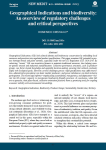Cristallo D. (2025). Geographical indications and biodiversity: an overview of regulatory challenges and critical perspectives. New Medit, 01/07/2025, vol. 24, n. 3, p. 47-58.
https://doi.org/10.30682/nm2503e
https://doi.org/10.30682/nm2503e
| Titre : | Geographical indications and biodiversity: an overview of regulatory challenges and critical perspectives (2025) |
| Auteurs : | D. Cristallo |
| Type de document : | Article |
| Dans : | New Medit (vol. 24, n. 3, July 2025) |
| Article en page(s) : | p. 47-58 |
| Langues : | Anglais |
| Langues du résumé : | Anglais |
| Catégories : |
Catégories principales 04 - DEVELOPPEMENT LOCAL ET REGIONAL ; 4.1 - Territoire (généralités). Economie Régionale et Spatiale. Aménagement du TerritoireThésaurus IAMM INDICATION GEOGRAPHIQUE PROTEGEE ; LABEL DE QUALITE ; BIODIVERSITE ; CONSERVATION DES RESSOURCES ; EUROPE |
| Résumé : | Geographical Indications (GIs) link cultural identity and biodiversity conservation by embedding local resources and practices into regulated product specifications. This paper examines GIs'potential to protect heritage breeds and plant varieties, especially under the new EU Regulation (EU) 2024/1143. By valorising "terroir," GIs can incentivize farmers to maintain traditional resources, thus helping counter genetic erosion and industrial standardization. Collective governance structures, such as producer groups, can foster shared knowledge and equitable decision-making, ensuring that cultural continuity aligns with ecological goals. However, several challenges persist: rigid specifications may stifle innovation, administrative procedures can deter smaller producers, and power imbalances can limit inclusive participation. The recent legal reforms-emphasizing sustainability, transparency, and digitization-bolster the GI systems' capacity to incorporate biodiversity-friendly practices. In conclusion, while GIs are no panacea, their place-based, collective orientation positions them as promising tools for coupling economic viability with environmental stewardship. |
| Cote : | En ligne |
| URL / DOI : | https://doi.org/10.30682/nm2503e |







